Potato Zero-Tillage and Mulching Is Promising in Achieving Agronomic Gain in Asia
Abstract
:1. Introduction
2. Materials and Methods
2.1. Systematic Review
2.2. Analysis of the Literature
2.3. Potential Rice-Potato Area Calculation in Asia
3. Results and Discussions
3.1. Context and Antecedents for Moving Forward to PZTM in Asian Rice-Systems
3.2. Productivity KPI: Yield and Profitability
3.3. Resource Efficiency KPI: Water Productivity and Nutrient-Use Efficiency
3.4. Soil Health KPI
3.5. C Footprint
3.6. Weed Control
3.7. Additional Considerations before Moving Forward to PZTM Technology
4. Conclusions
Author Contributions
Funding
Institutional Review Board Statement
Informed Consent Statement
Data Availability Statement
Acknowledgments
Conflicts of Interest
References
- Godfray, H.C.J.; Garnett, T. Food security and sustainable intensification. Philos. Trans. R. Soc. B Biol. Sci. 2014, 369, 20120273. [Google Scholar] [CrossRef] [PubMed]
- Pretty, J.; Bharucha, Z.P. Sustainable intensification in agricultural systems. Ann. Bot. 2014, 114, 1571–1596. [Google Scholar] [CrossRef] [PubMed]
- Garnett, T.; Appleby, M.C.; Balmford, A.; Bateman, I.J.; Benton, T.G.; Bloomer, P.; Burlingame, B.; Dawkins, M.; Dolan, L.; Fraser, D.; et al. Sustainable intensification in agriculture: Premises and policies. Science 2013, 341, 33–34. [Google Scholar] [CrossRef] [PubMed]
- Zhang, X.; Yao, G.; Vishwakarma, S.; Dalin, C.; Komarek, A.M.; Kanter, D.R.; Davis, K.F.; Pfeifer, K.; Zhao, J.; Zou, T.; et al. Quantitative assessment of agricultural sustainability reveals divergent priorities among nations. One Earth 2021, 4, 1262–1277. [Google Scholar] [CrossRef]
- OECD. OECD Studies on Water: Water Risk Hotspots for Agriculture; Read online; OECD Publishing: Paris, France, 2017; pp. 25–96. [Google Scholar] [CrossRef]
- Bhatt, R.; Kukal, S.S.; Busari, M.A.; Arora, S.; Yadav, M. Sustainability issues on rice–wheat cropping system. Int. Soil Water Conserv. Res. 2016, 4, 64–74. [Google Scholar] [CrossRef] [Green Version]
- Xu, X.; Sharma, P.; Shu, S.; Lin, T.S.; Ciais, P.; Tubiello, F.N.; Smith, P.; Campbell, N.; Jain, A.K. Global greenhouse gas emissions from animal-based foods are twice those of plant-based foods. Nat. Food 2021, 2, 724–732. [Google Scholar] [CrossRef]
- Bhatt, R.; Kaur, R.; Ghosh, A. Strategies to Practice Climate-Smart Agriculture to Improve the Livelihoods Under the Rice-Wheat Cropping System in South Asia. In Sustainable Management of Soil and Environment; Meena, R., Kumar, S., Bohra, J., Jat, M., Eds.; Springer: Singapore, 2019; pp. 29–71. [Google Scholar] [CrossRef]
- Liu, B.; Gu, W.; Yang, Y.; Lu, B.; Wang, F.; Zhang, B.; Bi, J. Promoting potato as staple food can reduce the carbon–land–water impacts of crops in China. Nat. Food 2021, 2, 570–577. [Google Scholar] [CrossRef]
- Chauhan, B.S.; Mahajan, G.; Sardana, V.; Timsina, J.; Jat, M.L. Productivity and sustainability of the rice–wheat cropping system in the Indo-Gangetic Plains of the Indian subcontinent: Problems, opportunities, and strategies. In Advances in Agronomy; Sparks, D., Ed.; Elsevier: Amsterdam, The Netherlands, 2012; pp. 315–369. [Google Scholar] [CrossRef]
- Gathala, M.K.; Laing, A.M.; Tiwari, T.P.; Timsina, J.; Islam, S.; Bhattacharya, P.M.; Dhar, T.; Ghosh, A.; Sinha, A.; Chowdhury, A.K.; et al. Energy-efficient, sustainable crop production practices benefit smallholder farmers and the environment across three countries in the Eastern Gangetic Plains, South Asia. J. Clean. Prod. 2020, 246, 118982. [Google Scholar] [CrossRef]
- Islam, S.; Gathala, M.K.; Tiwari, T.P.; Timsina, J.; Laing, A.M.; Maharjan, S.; Chowdhury, A.K.; Bhattacharya, P.M.; Dhar, T.; Mitra, B.; et al. Conservation agriculture based sustainable intensification: Increasing yields and water productivity for smallholders of the Eastern Gangetic Plains. Field Crop. Res. 2019, 238, 1–17. [Google Scholar] [CrossRef]
- Jat, H.S.; Choudhary, K.M.; Nandal, D.P.; Yadav, A.K.; Poonia, T.; Singh, Y.; Sharma, P.C.; Jat, M.L. Conservation Agriculture-based Sustainable Intensification of Cereal Systems Leads to Energy Conservation, Higher Productivity and Farm Profitability. Environ. Manag. 2020, 65, 774–786. [Google Scholar] [CrossRef]
- FAO; ITPS. Recarbonizing Global Soils—A Technical Manual of Recommended Management Practices. Volume 6: Forestry, Wetlands, and Urban Soils–Case Studies, 1st ed.; FAO: Roma, Italy, 2021; pp. 55–95. [Google Scholar] [CrossRef]
- CIP. CIP Annual Report 2020. Build, Innovate, Transform: Collaborative Solutions for Global Challenges. (Report); International Potato Center: Lima, Peru, 2021; 40p. [Google Scholar] [CrossRef]
- Lu, Y.; Kear, P.; Lu, X.; Gatto, M. The Status and Challenges of Sustainable Intensification of Rice-Potato Systems in Southern China. Am. J. Potato Res. 2021, 98, 361–373. [Google Scholar] [CrossRef]
- Gatto, M.; Petsakos, A.; Hareau, G. Sustainable Intensification of Rice-Based Systems with Potato in Eastern Indo-Gangetic Plains. Am. J. Potato Res. 2020, 97, 162–174. [Google Scholar] [CrossRef] [Green Version]
- Sarangi, S.K.; Maji, B.; Sharma, P.C.; Digar, S.; Mahanta, K.K.; Burman, D.; Mandal, U.K.; Mandal, S.; Mainuddin, M. Potato (Solanum tuberosum L.) Cultivation by Zero Tillage and Paddy Straw Mulching in the Saline Soils of the Ganges Delta. Potato Res. 2021, 64, 277–305. [Google Scholar] [CrossRef]
- Gatto, M.; Hareau, G.; Pradel, W.; Suarez, V.; Qin, J. Release and Adoption of Improved potato Varieties in Southeast and South Asia; Social Sciences Working Paper; International Potato Center: Lima, Peru, 2018; 42p. [Google Scholar] [CrossRef]
- Hareau, G.; Kleinwechter, U.; Pradel, W.; Suarez, V.; Okello, J.J.; Vikraman, S. Strategic Assessment of Research Priorities for Potato; (Working Paper); CGIAR Research Program on Roots, Tubers and Bananas: Lima, Peru, 2018; 27p, Available online: https://hdl.handle.net/10568/69246 (accessed on 1 May 2022).
- Pradel, W.; Gatto, M.; Hareau, G.; Pandey, S.K.; Bhardway, V. Adoption of potato varieties and their role for climate change adaptation in India. Clim. Risk Manag. 2019, 23, 114–123. [Google Scholar] [CrossRef] [PubMed]
- Saito, K.; Six, J.; Komatsu, S.; Snapp, S.; Rosenstock, T.; Arouna, A.; Cole, S.; Taulya, G.; Vanlauwe, B. Agronomic gain: Definition, approach, and application. Field Crop. Res. 2021, 270, 108193. [Google Scholar] [CrossRef]
- Erenstein, O.; Laxmi, V. Zero tillage impacts in India’s rice–wheat systems: A review. Soil Tillage Res. 2008, 100, 1–14. [Google Scholar] [CrossRef]
- R Core Team. R Software, Version, 5.3.3; Available online: https://www.r-project.org/ (accessed on 20 October 2021).
- Grames, E.M.; Stillman, A.N.; Tingley, M.W.; Elphick, C.S. An automated approach to identifying search terms for systematic reviews using keyword co-occurrence networks. Methods Ecol. Evol. 2019, 10, 1645–1654. [Google Scholar] [CrossRef]
- Sweileh, W.M. Bibliometric analysis of peer-reviewed literature on food security in the context of climate change from 1980 to 2019. Agric. Food Secur. 2020, 9, 11. [Google Scholar] [CrossRef]
- Locatelli, B.; Homberger, J.M.; Ochoa-Tocachi, B.; Bonnesoeur, V.; Román, F.; Drenkhan, F.; Buytaert, W. Impactos de las Zanjas de Infiltración en el Agua y los Suelos: ¿Qué Sabemos? CGIAR Infraestructura Natural para la Seguridad Hídrica, Forest Trends: Lima, Peru, 2020; 16p, Available online: https://www.forest-trends.org//wp-content//uploads//2020//05//Impactos-de-las-zanjas-de-infiltraci%C3%B3n-en-el-agua-y-los-suelos.pdf (accessed on 1 May 2022).
- Bonnesoeur, V.; Locatelli, B.; Ochoa-Tocachi, B. Impactos de la Forestación en el Agua y los Suelos de los Andes: ¿Qué Sabemos? CGIAR Infraestructura Natural para la Seguridad Hídrica, Forest Trends: Lima, Peru, 2019; 12p, Available online: https://agritrop.cirad.fr/591482/1/Bonnesoeur%202019%20Impacto%20de%20la%20Forestacion%20en%20el%20Agua%20y%20Suelos.pdf (accessed on 1 May 2022).
- Zhu, W.; Lű, A.; Jia, S. Estimation of daily maximum and minimum air temperature using MODIS land surface temperature products. Remote Sens. Environ. 2013, 130, 62–73. [Google Scholar] [CrossRef]
- Minhas, J.S.; Rawat, S.; Govindakrishnan, P.M.; Kumar, D. Possibilities of enhancing potato production in non-traditional areas. Potato J. 2011, 38, 14–17. Available online: https://www.researchgate.net/profile/Devendra-Kumar-5/publication/278024049_Possibilities_of_enhancing_potato_production_in_non-traditional_areas/links/55796afa08aeb6d8c01fc559/Possibilities-of-enhancing-potato-production-in-non-traditional-areas.pdf (accessed on 1 May 2022).
- International Food Policy Research Institute (IFPRI). Global Spatially-Disaggregated Crop Production Statistics Data for 2010; Version 2.0; Harvard Dataverse: Harvard, MA, USA, 2019. [Google Scholar] [CrossRef]
- Yu, Q.; You, L.; Wood-Sichra, U.; Ru, Y.; Joglekar, A.K.; Fritz, S.; Xiong, W.; Lu, M.; Wu, W.; Yang, P. A cultivated planet in 2010–Part 2: The global gridded agricultural-production maps. Earth Syst. Sci. Data 2020, 12, 3545–3572. [Google Scholar] [CrossRef]
- Yang, M.; Wang, G.; Lazin, R.; Shen, X.; Anagnostou, E. Impact of planting time soil moisture on cereal crop yield in the Upper Blue Nile Basin: A novel insight towards agricultural water management. Agric. Water Manag. 2021, 243, 106430. [Google Scholar] [CrossRef]
- ESRI. ArcGIS Desktop Release 10.1; Environmental Systems Research Institute: Redlands, CA, USA, 2012. [Google Scholar]
- CIP. CIP Annual Report 2019. Discovery to Impact: Science-Based Solutions for Global Challenges. (Report); International Potato Center: Lima, Peru, 2021; 37p. [Google Scholar] [CrossRef]
- Pulok, M.A.I.; Roy, T.S.; Bhuiyan, M.S.R.; Haque, M.N.; Nur-unnahar, N.U. Effect of Potassium and Mulches on Growth, Yield and Economics of Potato. Potato J. 2016, 43, 200–210. Available online: http://epubs.icar.org.in/ejournal/index.php/PotatoJ/article/view/66622/28545 (accessed on 1 May 2022).
- Satapathy, B.S.; Singh, T.; Pun, K.B.; Saikia, K.; Rautaray, S.K. Influence of dates of planting and mulching on growth and tuber yield of potato (Solanum tuberosum) in rice (Oryza sativa) fallows of shallow lowland of Asom. Indian J. 2016, 61, 455–459. Available online: https://www.indianjournals.com/ijor.aspx?target=ijor:ija&volume=61&issue=4&article=008 (accessed on 1 May 2022).
- Sarangi, S.; Maji, B.; Digar, S.; Mahanta, K.; Sharma, P.; Mainuddin, M. Zero tillage potato cultivation—An innovative technology for coastal saline soils. Indian Farm 2018, 68, 23–26. Available online: https://www.researchgate.net/profile/Sukanta-Sarangi/publication/326677803_Zero_tillage_potato_cultivation_-_an_innovative_technology_for_coastal_saline_soils/links/5b5dc30baca272a2d6736036/Zero-tillage-potato-cultivation-an-innovative-technology-for-coastal-saline-soils.pdf (accessed on 1 May 2022).
- Sarangi, S.K.; Maji, B.; Sharma, P.C.; Digar, S.; Mahanta, K.K.; Burman, D.; Mandal, U.K.; Mandal, S.; Mainuddin, M. Zero Tilled-Paddy Straw Mulched Potato (Solanum tuberosum) Cultivation in the Coastal Saline Soils Reduce Soil Salinity, Increase Yield and Profitability. Proceedings 2020, 36, 147. [Google Scholar] [CrossRef] [Green Version]
- Ali, M.A.; Shahadat, M.K.; Rashid, M. Performance of Zero Tillage Potato Cultivation with Different Mulch Materials in the South-Western Saline Area of Bangladesh. Proceedings 2019, 36, 29. [Google Scholar] [CrossRef] [Green Version]
- Li, Q.; Li, H.; Zhang, L.; Zhang, S.; Chen, Y. Mulching improves yield and water-use efficiency of potato cropping in China: A meta-analysis. Field Crop. Res. 2018, 221, 50–60. [Google Scholar] [CrossRef]
- Lehar, L.; Wardiyati, T.; Moch Dawam, M.; Suryanto, A. Influence of mulch and plant spacing on yield of Solanum tuberosum L. cv. Nadiya at medium altitude. Int. Food Res. J. 2017, 24, 1338–1344. Available online: http://www.ifrj.upm.edu.my/24%20(03)%202017/(60).pdf (accessed on 1 May 2022).
- Girton, S.S.; Singh, N. Effect of organic mulches on the hydrothermal regime of soil and growth of potato crop in Northern India. Plant Soil 1974, 40, 33–47. [Google Scholar] [CrossRef]
- Baruah, S.; Mohanty, S. Sustainable Intensification of Potato Cultivation in Asia. In Scaling-Up Solutions for Farmers: Technology, Partnerships and Convergence; Wani, S.P., Raju, K.V., Bhattacharyya, T., Eds.; Springer International Publishing: Cham, Switherlands, 2021; pp. 307–322. [Google Scholar] [CrossRef]
- Thakur, S.S.; Chandel, R.; Narang, M.K. Studies on straw management techniques using paddy-straw chopper cum spreader along with various tillage practices and subsequent effect of various sowing techniques on wheat yield and economics. AMA 2018, 49, 52–67. Available online: https://www.researchgate.net/profile/Rupinder-Chandel/publication/333566641_Studies_on_Straw_Management_Techniques_Using_Paddy-Straw_Chopper_Cum_Spreader_Along_With_Various_Tillage_Practices_and_Subsequent_Effect_of_Various_Sowing_Techniques_on_Wheat_Yield_and_Economics/links/5cf4f715a6fdcc8475003fde/Studies-on-Straw-Management-Techniques-Using-Paddy-Straw-Chopper-Cum-Spreader-Along-With-Various-Tillage-Practices-and-Subsequent-Effect-of-Various-Sowing-Techniques-on-Wheat-Yield-and-Economics.pdf (accessed on 1 May 2022).
- Bhatt, R.; Singh, P.; Hossain, A.; Timsina, J. Rice–wheat system in the northwest Indo-Gangetic plains of South Asia: Issues and technological interventions for increasing productivity and sustainability. Paddy Water Environ. 2021, 19, 345–365. [Google Scholar] [CrossRef]
- SAARC Energy Centre. Possible Uses of Crop Residue for Energy Generation Instead of Open Burning; SAARC Energy Centre: Islamabad, Pakistan, 2019; Available online: https://www.saarcenergy.org/programmes-2019 (accessed on 1 May 2022).
- Liu, T.; Mickley, L.J.; Singh, S.; Jain, M.; DeFries, R.S.; Marlier, M.E. Crop residue burning practices across north India inferred from household survey data: Bridging gaps in satellite observations. Atmos. Environ. X 2020, 8, 100091. [Google Scholar] [CrossRef]
- Cheng, K.; Pan, G.; Smith, P.; Luo, T.; Li, L.; Zheng, J.; Zhang, X.; Han, X.; Yan, M. C footprint of China’s crop production-an estimation using agro-statistics data over 1993–2007. Agric. Ecosyst. Environ. 2011, 142, 231–237. [Google Scholar] [CrossRef]
- Verma, S.K.; Singh, S.B.; Prasad, S.K.; Meena, R.N.; Meena, R.S. Influence of irrigation regimes and weed management practices on water use and nutrient uptake in wheat (Triticum aestivum L. Emend. Fiori and Paol.). Bangladesh J. Bot. 2015, 44, 437–442. [Google Scholar] [CrossRef]
- Tang, H.; Xiao, X.; Tang, W.; Wang, K.; Sun, J.; Li, W.; Yang, G. Effects of winter covering crop residue incorporation on CH4 and N2O emission from double-cropped paddy fields in southern China. Environ. Sci. Pollut. Res. 2015, 22, 12689–12698. [Google Scholar] [CrossRef] [PubMed] [Green Version]
- Sadawarti, M.J.; Singh, S.P.; Kumar, V.; Lal, S.S. Effect of mulching and irrigation scheduling on potato cultivar kufri chipsona-1 in central India. Potato J. 2013, 40, 65–71. Available online: https://www.researchgate.net/profile/Murlidhar-Sadawarti/publication/342048844_EFFECT_OF_MULCHING_AND_IRRIGATION_SCHEDULING_ON_POTATO_CULTIVAR_KUFRI_CHIPSONA-1_IN_CENTRAL_INDIA/links/5edfaa6d45851516e6629d42/EFFECT-OF-MULCHING-AND-IRRIGATION-SCHEDULING-ON-POTATO-CULTIVAR-KUFRI-CHIPSONA-1-IN-CENTRAL-INDIA.pdf (accessed on 1 May 2022).
- Kar, G.; Kumar, A. Effects of irrigation and straw mulch on water use and tuber yield of potato in eastern India. Agric. Water Manag. 2007, 94, 109–116. [Google Scholar] [CrossRef]
- Rautaray, S.K. Benefits of mulching with dried water hyacinth or paddy straw. Potato J. 2010, 37, 32–36. Available online: https://www.researchgate.net/profile/Sachin-Rautaray/publication/281062310_Benefits_of_mulching_with_dried_water_hyacinth_or_paddy_straw/links/57bae14c08ae202e6a564c33/Benefits-of-mulching-with-dried-water-hyacinth-or-paddy-straw.pdf (accessed on 1 May 2022).
- Shafiq, M.; Kaur, S. Weed Control Using Paddy Straw Mulch in Integration with Herbicides in Autumn Potato in North-West India. Potato Res. 2021, 64, 761–773. [Google Scholar] [CrossRef]
- Singh, C.B.; Singh, S.; Arora, V.K.; Sekhon, N.K. Residue Mulch Effects on Potato Productivity and Irrigation and Nitrogen Economy in a Subtropical Environment. Potato Res. 2015, 58, 245–260. [Google Scholar] [CrossRef]
- Genger, R.K.; Rouse, D.I.; Charkowski, A.O. Straw mulch increases potato yield and suppresses weeds in an organic production system. Biol. Agric. Hortic 2018, 34, 53–69. [Google Scholar] [CrossRef]
- Bhullar, M.S.; Kaur, S.; Kaur, T.; Jhala, A.J. Integrated Weed Management in Potato Using Straw Mulch and Atrazine. HortTechnology 2015, 25, 335–339. [Google Scholar] [CrossRef] [Green Version]
- Brar, A.S.; Buttar, G.S.; Thind, H.S.; Singh, K.B. Improvement of Water Productivity, Economics and Energetics of Potato through Straw Mulching and Irrigation Scheduling in Indian Punjab. Potato Res. 2019, 62, 465–484. [Google Scholar] [CrossRef]
- Mal, T.; Walia, S.S.; Saini, K.S. Productivity and economics of different cropping systems in relation to tillage, mulching and fertilizer management practices in north-western Indo-Gangetic Plains of India. Indian J. Agric. Sci. 2018, 88, 216–221. Available online: http://epubs.icar.org.in/ejournal/index.php/IJAgS/article/view/79171 (accessed on 1 May 2022).
- Rautaray, S.K. Effect of mulching on yield and economics of rainfed rice (Oryza sativa)-based cropping sequences in lower Assam. Indian J. Agron. 2005, 50, 13–15. Available online: https://www.indianjournals.com/ijor.aspx?target=ijor:ija&volume=50&issue=1&article=004 (accessed on 1 May 2022).
- Dash, S.N.; Pushpavathi, Y.; Behera, S. Effect of Irrigation and Mulching on Growth, Yield and Water Use Efficiency of Potato. Int. J. Curr. Microbiol. Appl. Sci. 2018, 7, 2582–2587. [Google Scholar] [CrossRef]
- Bhagat, P.; Gosal, S.K.; Singh, C.B. Effect of mulching on soil environment, microbial floraand growth of potato under field conditions. Indian J. Agric. Res. 2016, 50, 542–546. [Google Scholar] [CrossRef]
- Prasad, D.; Rana, D.S.; Rana, K.S.; Rajpoot, S.K. Effect of tillage practices and crop diversification on productivity, resource-use efficiency and economics of maize (Zea mays)/soybean (Glycine max)-based cropping systems. Indian J. Agron. 2014, 59, 534–541. Available online: https://www.researchgate.net/profile/Sudhir-Rajpoot/publication/286285203_Effect_of_tillage_practices_and_crop_diversification_on_productivity_resource-use_efficiency_and_economics_of_maize_Zea_mayssoybean_Glycine_max-based_cropping_systems/links/56891f6c08ae051f9af74489/Effect-of-tillage-practices-and-crop-diversification-on-productivity-resource-use-efficiency-and-economics-of-maize-Zea-mays-soybean-Glycine-max-based-cropping-systems.pdf (accessed on 1 May 2022).
- Jackson, M.T. Revitalizing the Rice-Wheat Cropping Systems of the Indo-Gangetic Plains: Adaptation and Adoption of Resource-Conserving Technologies in India, Bangladesh, and Nepal. (Report). International Rice Research Institute Ref. No. DPPC2007-100. Available online: https://pdf.usaid.gov/pdf_docs/Pdacp630.pdf (accessed on 1 May 2022).
- Naresh, R.K.; Gupta, R.K.; Prasad, K.K.; Tomar, S. Impact of conservation tillage on soil organic carbon storage and soil labile organic carbon fractions of different textured soils under rice-wheat cropping system: A review. J. Pharmacogn. Phytochem. 2018, 7, 2545–2562. Available online: https://www.phytojournal.com/archives/2018/vol7issue3/PartAH/7-3-240-546.pdf (accessed on 1 May 2022).
- Chaudhary, A.; Chhokar, R.K.; Yadav, D.B.; Sindhu, V.K.; Ram, H.; Rawal, S.; Khedwal, R.S.; Sharma, R.K.; Gill, S.C. In-situ paddy straw management practices for higher resource use efficiency and crop productivity in Indo-Gangetic Plains (IGP) of India. J. Cereal Res. 2019, 11, 172–198. [Google Scholar] [CrossRef] [Green Version]
- Wanhalinna, W. Carbon Footprint of Bread, 1st ed.; University of Helsinki: Helsinki, Finland, 2010; p. 79. [Google Scholar]
- Goel, L.; Shankar, V.; Sharma, R.K. Investigations on effectiveness of wheat and rice straw mulches on moisture retention in potato crop (Solanum tuberosum L.). Int. J. Recycl. Org. Waste Agric. 2019, 8, 345–356. [Google Scholar] [CrossRef] [Green Version]
- Bijay-Singh; Shan, Y.H.; Johnson-Beebout, S.E.; Yadvinder-Singh; Buresh, R.J. Chapter 3 Crop Residue Management for Lowland Rice-Based Cropping Systems in Asia. In Advances in Agronomy; Sparks, D., Ed.; Elsevier: Amsterdam, The Netherlands, 2008; pp. 117–199. [Google Scholar] [CrossRef]
- Gupta, R.K.; Yadvinder-Singh; Ladha, J.K.; Bijay-Singh; Singh, J.; Singh, G.; Pathak, H. Yield and Phosphorus Transformations in a Rice-Wheat System with Crop Residue and Phosphorus Management. Soil Sci. Soc. Am. J. 2007, 71, 1500–1507. [Google Scholar] [CrossRef]
- Acharya, C.L.; Kapur, O.C. Using organic wastes as compost and mulch for potato (Solanum tuberosum) in low water-retaining hill soils of north-west India. Indian J. Agric. Sci. 2001, 71, 306–309. Available online: https://agris.fao.org/agris-search/search.do?recordID=IN2022004392 (accessed on 1 May 2022).
- Kumar, V.; Singh, S.; Chhokar, R.S.; Malik, R.K.; Brainard, D.C.; Ladha, J.K. Weed Management Strategies to Reduce Herbicide Use in Zero-Till Rice–Wheat Cropping Systems of the Indo-Gangetic Plains. Weed Technol. 2013, 27, 241–254. [Google Scholar] [CrossRef] [Green Version]
- Sharma, R.K.; Srinivasa Babu, K.; Chhokar, R.S.; Sharma, A.K. Effect of tillage on termites, weed incidence and productivity of spring wheat in rice–wheat system of North Western Indian plains. Crop Prot. 2004, 23, 1049–1054. [Google Scholar] [CrossRef]
- Gupta, R.; Sayre, K. Paper Presented at International Workshop on Increasing Wheat Yield Potential, CIMMYT, Obregon, Mexico, 20–24 March 2006 Conservation Agriculture in South Asia. J. Agric. Sci. 2007, 145, 207–214. [Google Scholar] [CrossRef]
- Bhatt, R. Soil Water Dynamics and Water Productivity of Rice-Wheat System under Different Establishment Methods. Ph.D. Thesis, Punjab Agricultural University, Ludhiana, India, 2015. [Google Scholar]
- Eggleston, H.S.; Buendia, L.; Miwa, K.; Ngara, T.; Tanabe, K. 2006 IPCC Guidelines for National Greenhouse Gas Inventories. Volume 4 Agriculture, Forestry and Other Land Use. Available online: https://www.ipcc-nggip.iges.or.jp/public/2006gl/vol4.html (accessed on 1 May 2022).
- Kaliappan, S.B.; Gunasekaran, Y.; Smyrna, R.; Meena, R.S. Soil and Environmental Management. In Sustainable Management of Soil and Environment; Meena, R., Kumar, S., Bohra, J., Jat, M., Eds.; Springer: Singapore, 2019; pp. 1–27. [Google Scholar] [CrossRef]
- Lal, R. Soil Carbon Sequestration Impacts on Global Climate Change and Food Security. Science 2004, 304, 1623–1627. [Google Scholar] [CrossRef] [Green Version]
- Tanveer, S.K.; Wen, X.; Lu, X.L.; Zhang, J.; Liao, Y. Tillage, Mulch and N Fertilizer Affect Emissions of CO2 under the Rain Fed Condition. PLoS ONE 2013, 8, e7214. [Google Scholar] [CrossRef] [Green Version]
- Huang, J.; Chen, Y.; Pan, J.; Liu, W.; Yang, G.; Xiao, X.; Zheng, H.; Tang, W.; Tang, H.; Zhou, L. Carbon footprint of different agricultural systems in China estimated by different evaluation metrics. J. Clean. Prod. 2019, 22, 939–948. [Google Scholar] [CrossRef]
- Chhokar, R.S.; Sharma, R.K.; Jat, G.R.; Pundir, A.K.; Gathala, M.K. Effect of tillage and herbicides on weeds and productivity of wheat under rice–wheat growing system. Crop Prot. 2007, 26, 1689–1696. [Google Scholar] [CrossRef]
- Murphy, S.D.; Clements, D.R.; Belaoussoff, S.; Kevan, P.G.; Swanton, C.J. Promotion of weed species diversity and reduction of weed seedbanks with conservation tillage and crop rotation. Weed Sci. 2006, 54, 69–77. [Google Scholar] [CrossRef]
- Thomas-Sharma, S.; Abdurahman, A.; Ali, S.; Andrade-Piedra, J.L.; Bao, S.; Charkowski, A.O.; Kadian, D.C.; Kromann, P.; Struik, P.C.; Torrance, L.; et al. Seed degeneration in potato: The need for an integrated seed health strategy to mitigate the problem in developing countries. Plant Pathol. 2016, 65, 3–16. [Google Scholar] [CrossRef] [Green Version]
- Mohanty, S.; Baruah, S.; Reddy, R. Apical Rooted Cuttings for Cheaper Potato Seeds. Research Brief 04; International Potato Center: Lima, Peru, 2020; 4p, Available online: https://hdl.handle.net/10568/110006 (accessed on 1 May 2022).
- Ramírez, D.; Kreuze, J.; Amoros, W.; Valdivia-Silva, J.; Ranck, J.; Garcia, S.; Salas, E. Yactayo Extreme salinity as a challenge to grow potatoes under Mars-like soil conditions: Targeting promising genotypes. Int. J. Astrobiol. 2019, 18, 18–24. [Google Scholar] [CrossRef] [Green Version]
- Srinivasan, R. Rethinking digital cultures and divides: The case for reflective media. Inf. Soc. 2012, 28, 24–36. [Google Scholar] [CrossRef]
- Bentley, J.W.; Van Mele, P.; Barres, N.F.; Okry, F.; Wanvoeke, J. Smallholders download and share videos from the Internet to learn about sustainable agriculturee. Int. J. Agric. Sustain. 2019, 17, 92–107. [Google Scholar] [CrossRef]
- Van Mele, P.; Okry, F.; Wanvoeke, J.; Fousseni Barres, N.; Malone, P.; Rodgers, J.; Rahman, E.; Salahuddin, A. Quality farmer training videos to support South-South learning. CSIT 2018, 6, 245–255. [Google Scholar] [CrossRef]
- Kawarazuka, N.; Goswami, B. Opportunities and Constraints for Women: Recommendations for Building Gender Responsive Potato Value Chains in Assam, India; The International Potato Center: Lima, Peru, 2019; 19p, Available online: https://cgspace.cgiar.org/handle/10568/103195 (accessed on 1 May 2022).
- Haverkort, A.J.; Hillier, J.G. Cool farm tool–potato: Model description and performance of four production systems. Potato Res. 2011, 54, 355–369. [Google Scholar] [CrossRef] [Green Version]
- Feliciano, D.; Nayak, D.R.; Vetter, S.H.; Hillier, J. CCAFS-MOT-A tool for farmers, extension services and policy-advisors to identify mitigation options for agriculture. Agric. Syst. 2017, 154, 100–111. [Google Scholar] [CrossRef] [Green Version]
- Haverkort, A.J.; Sandaña, P.; Kalazich, J. Yield gaps and ecological footprints of potato production systems in Chile. Potato Res. 2014, 57, 13–31. [Google Scholar] [CrossRef] [Green Version]
- Svubure, O.; Struik, P.C.; Haverkort, A.J.; Steyn, J.M. Carbon footprinting of potato (Solanum tuberosum L.) production systems in Zimbabwe. Outlook Agric. 2018, 47, 3–10. [Google Scholar] [CrossRef] [Green Version]
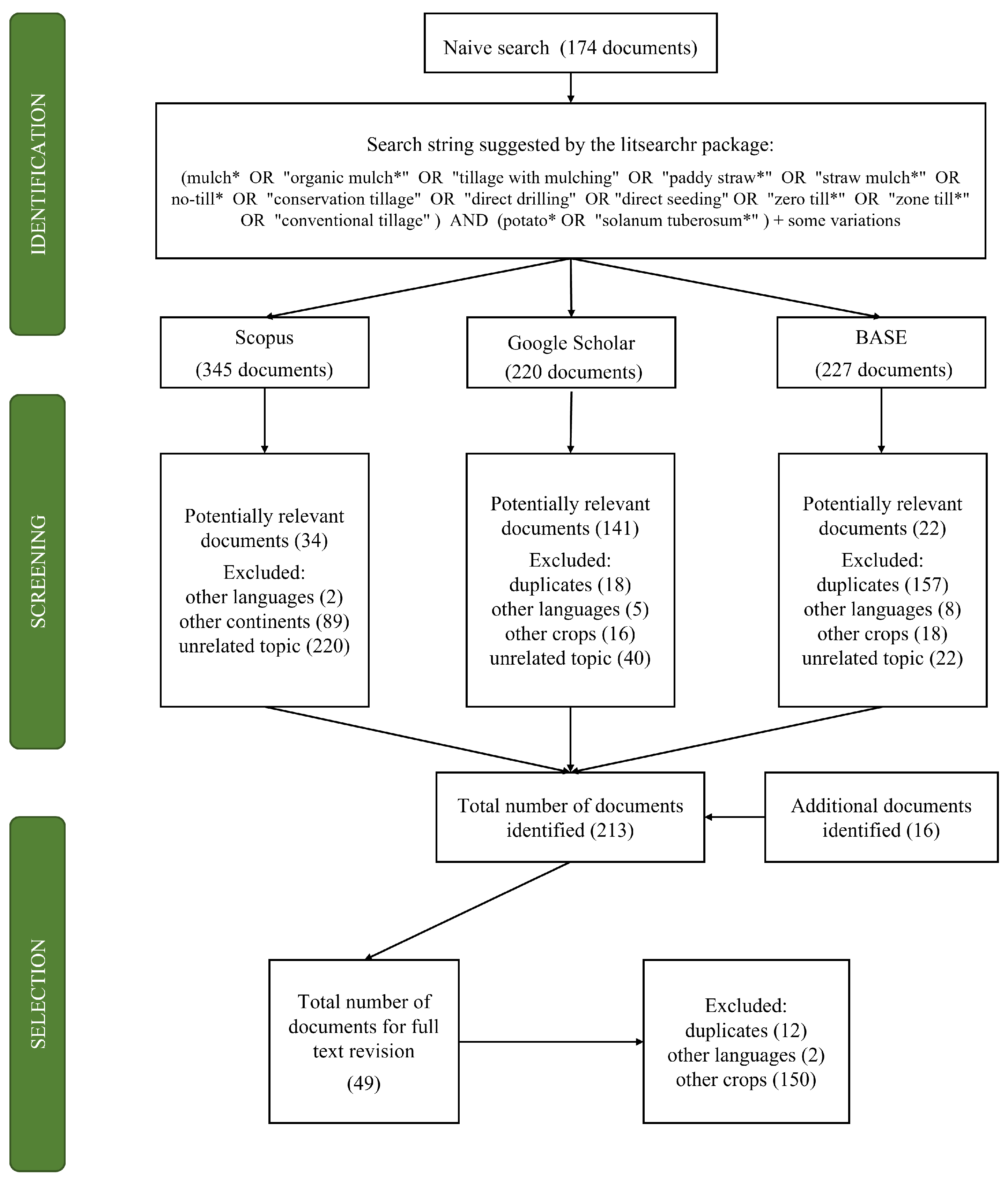
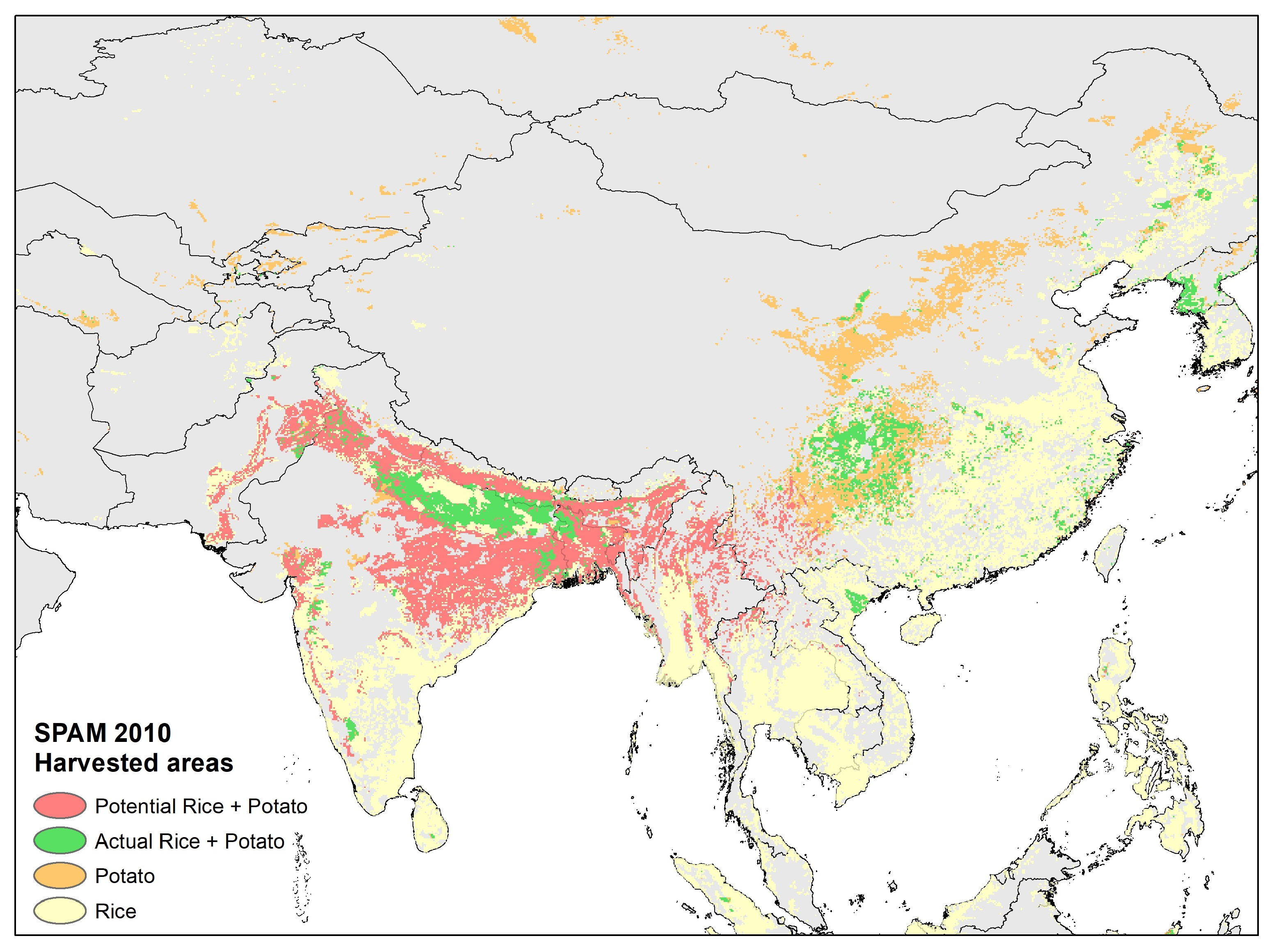
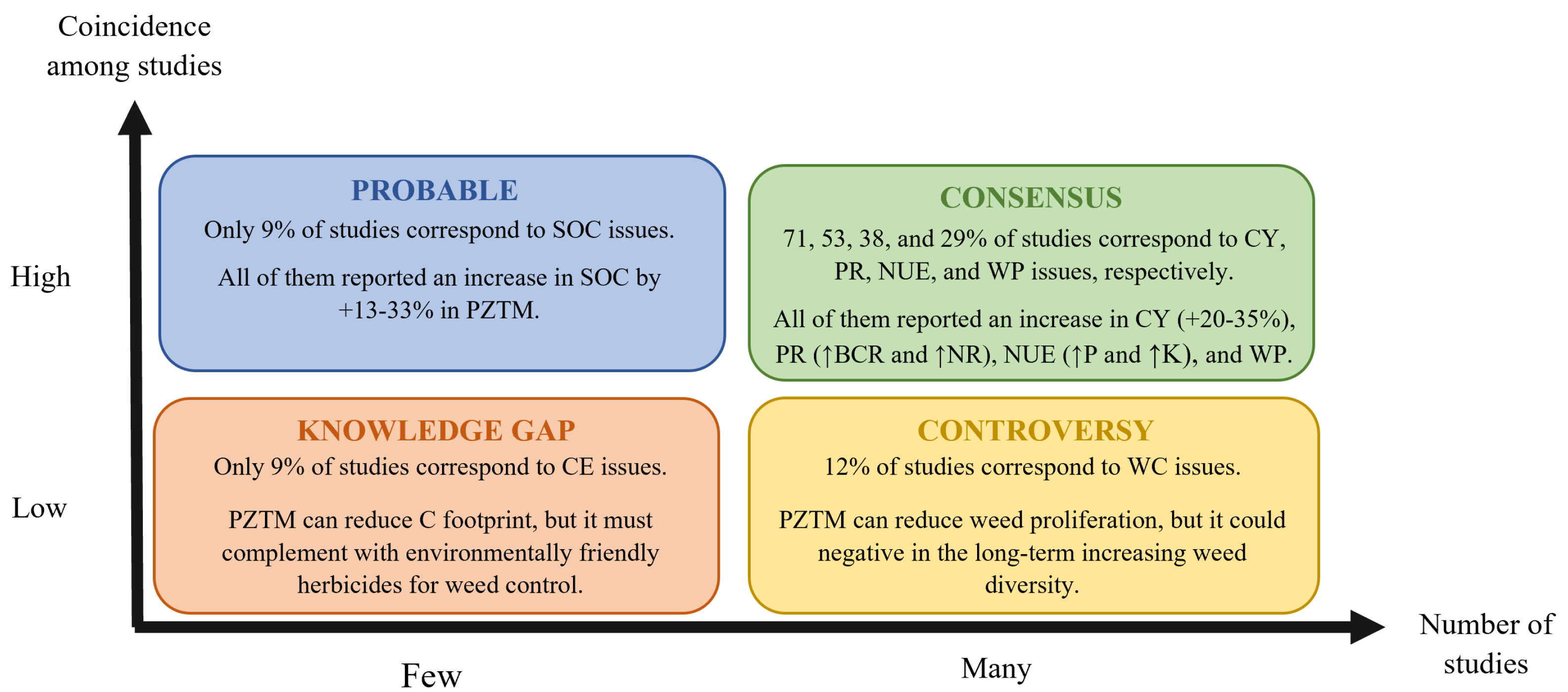
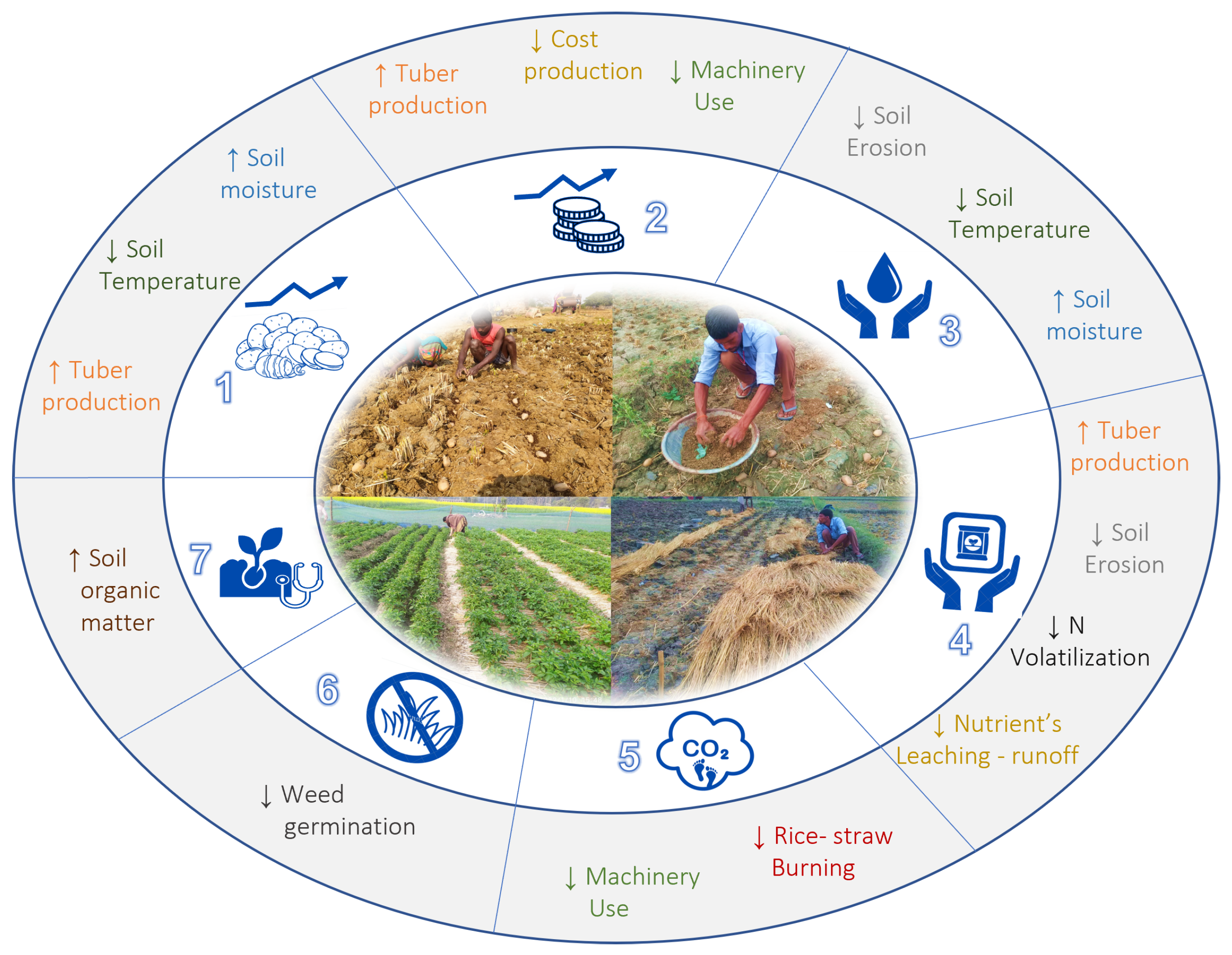
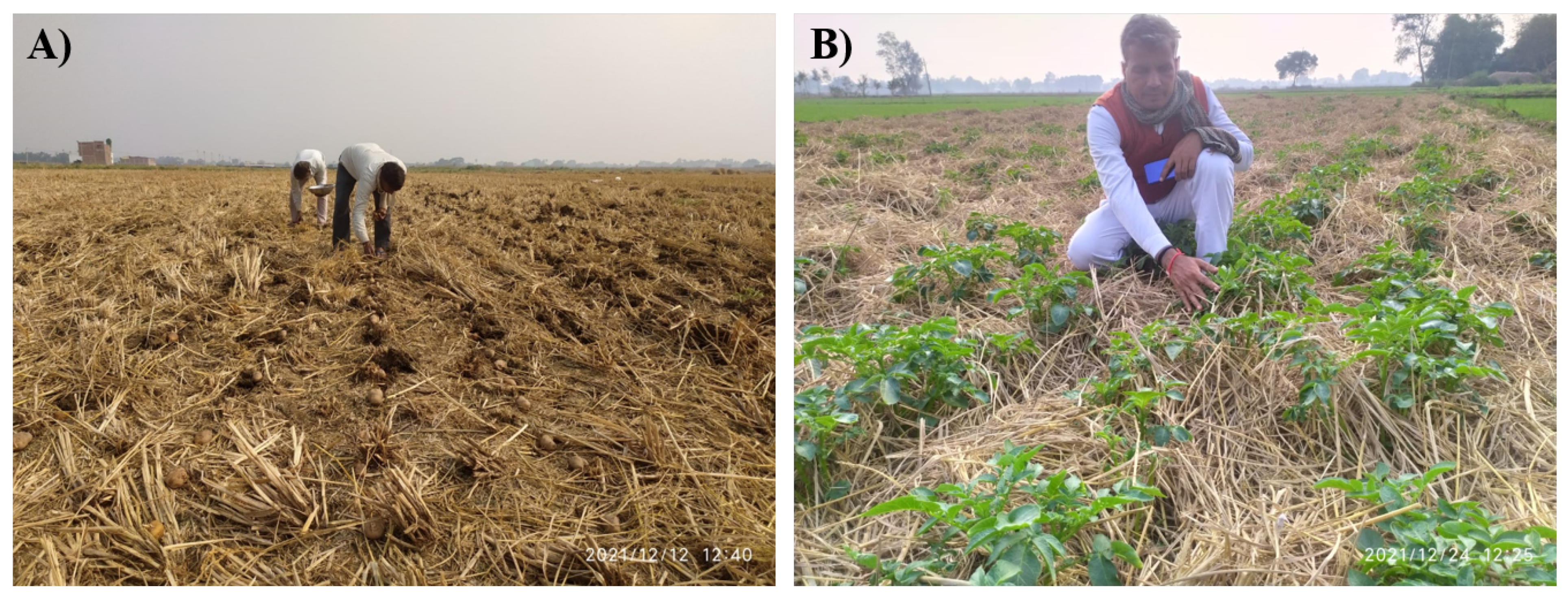
| Database | Search Equation | n |
|---|---|---|
| Scopus (Naïve search) | TITLE-ABS-KEY(“potato” AND (“zero till*” OR “no till*” OR “*straw mulch*” OR “organic mulch*”) OR “rice-wheat system*”) | 174 |
| Scopus (Litsearchr) | TITLE-ABS-KEY ( ( “mulch*” OR “organic mulch*” OR “tillage with mulching” OR “paddy straw*” OR “straw mulch*” OR “no-till*” OR “conservation tillage” OR “direct drilling” OR “direct seeding” OR “zero till*” OR “zone till*” OR “conventional tillage” ) AND ( “potato*” OR “solanum tuberosum*” ) ) | 345 |
| Google Scholar | potato* + (mulch* OR“organic mulch*” OR“tillage with mulching” OR“paddy straw*” OR“straw mulch*” OR“no-till*” OR“zero-till*” OR“zone till” OR“conservation OR“conventional tillage”OR“direct drilling” OR“direct seeding”) +“asia” | 220 |
| BASE | ((conservation sustainable intensification) agriculture) (productivity efficiency) AND (((zero no minium) till) mulch rice) AND potato AND asia-europe doctype:(122 13 14 15 16 17 18* 19 1A) | 227 |
| Technique | Combined with | Location | Key Performance Indicators | Weed Control and/or C Footprint | REF | ||||
|---|---|---|---|---|---|---|---|---|---|
| Productivity | Resource Use Efficiency | Soil Health | |||||||
| Yield | Profitability | WP * | NUE | SOC, SAL | |||||
| M | irrigation levels and soil textures | Ludhiana, India | ↑ 22–31% | 13,200 INR ha−1 of return | ↓ 90–100 mm IW ↓ T° | 90 kg N ha−1 saved | [56] | ||
| M | irrigation schedules | Madhya Pradesh, India | ↑ 10% | ↑ 4% NR | ↑ 10% WUE | ↑ P and K uptake | [52] | ||
| M | other mulched crops | Assam, India | ↑ 21% | ↑ 33% NR | [61] | ||||
| M | irrigation schedules | Odisha, India | ↑ 24–42% | ↑ P and K uptake | [53] | ||||
| M | plant spacing levels | East Java, Indonesia | ↑ 173% | ↓ T° | [42] | ||||
| M | plastic mulch | China | ↑ 12–17% | ↑ 8% | [41] | ||||
| M | herbicide (atrazine) | Ludhiana, India | ↑ 46% | up to 99% of weeds controlled | [58] | ||||
| M | herbicides (metribuzin, clodinafop) | Ludhiana, India | ↑ 100–135% | only mulch: 397 USD ha−1 NR, with herbicides: 62–513 USD ha−1 NR | 68–95% of weeds controlled | [55] | |||
| M | K concentration levels | Bangladesh | ↑ 16–53% NR | ↑ 28–107% | [36] | ||||
| M | other mulched crops, many potato varieties | Assam, India | ↑ 20% | ↑ 18–29% NR | [54] | ||||
| M | Different planting dates | Gerua, Kamrup, India | ↑ 24% | ↓ 16% incidence of common scab | [37] | ||||
| M | irrigation methods and schedules | Ludhiana, India | ↑ 41% | ↑ 811% NR | ↑ 42%, ↑ drainage, ↓ T°, ↑ | [59] | |||
| M | irrigation levels | Odisha, India | ↑ 5% | ↑ 24% NR | ↑ 5% WUE | [62] | |||
| M | N concentration levels | Ludhiana, India | ↑ T° | ↑ 33% SOC | [63] | ||||
| ZTM | early sowing of potato | Coastal region of India | ↑ 6% | ↑ 96% NR ↑ 60% BCR | ↓ 40% IW | [38] | |||
| ZTM | various tillage practices | Ludhiana, India | ↑ 12% | ↑ 16% BCR | [45] | ||||
| ZTM | foliar nutrients | West Bengal, India | ↑ 24–93% | ↓ 27% CC ↑ 147–498% NR | ↓ 31–38% IW | ↑ 13% SOC, ↓ 40% soil salinity | [39] | ||
| ZTM | fertilizers and other crops | Ludhiana, India | ↑ 4% | ↑ 24% BCR ↑ 16% NR | [60] | ||||
| ZTM | other crop systems | New Delhi, India | ↑ 7% | ↑ 13% NR | ↑ 28% | [64] | |||
| ZTM | different organic mulch materials | Bangladesh | ↑ 4–8% | ↓ 4% soil salinity | [40] | ||||
Publisher’s Note: MDPI stays neutral with regard to jurisdictional claims in published maps and institutional affiliations. |
© 2022 by the authors. Licensee MDPI, Basel, Switzerland. This article is an open access article distributed under the terms and conditions of the Creative Commons Attribution (CC BY) license (https://creativecommons.org/licenses/by/4.0/).
Share and Cite
Ramírez, D.A.; Silva-Díaz, C.; Ninanya, J.; Carbajal, M.; Rinza, J.; Kakraliya, S.K.; Gatto, M.; Kreuze, J. Potato Zero-Tillage and Mulching Is Promising in Achieving Agronomic Gain in Asia. Agronomy 2022, 12, 1494. https://doi.org/10.3390/agronomy12071494
Ramírez DA, Silva-Díaz C, Ninanya J, Carbajal M, Rinza J, Kakraliya SK, Gatto M, Kreuze J. Potato Zero-Tillage and Mulching Is Promising in Achieving Agronomic Gain in Asia. Agronomy. 2022; 12(7):1494. https://doi.org/10.3390/agronomy12071494
Chicago/Turabian StyleRamírez, David A., Cecilia Silva-Díaz, Johan Ninanya, Mariella Carbajal, Javier Rinza, Suresh K. Kakraliya, Marcel Gatto, and Jan Kreuze. 2022. "Potato Zero-Tillage and Mulching Is Promising in Achieving Agronomic Gain in Asia" Agronomy 12, no. 7: 1494. https://doi.org/10.3390/agronomy12071494
APA StyleRamírez, D. A., Silva-Díaz, C., Ninanya, J., Carbajal, M., Rinza, J., Kakraliya, S. K., Gatto, M., & Kreuze, J. (2022). Potato Zero-Tillage and Mulching Is Promising in Achieving Agronomic Gain in Asia. Agronomy, 12(7), 1494. https://doi.org/10.3390/agronomy12071494











